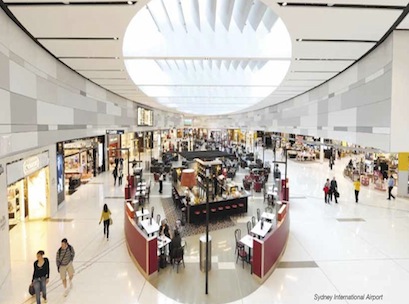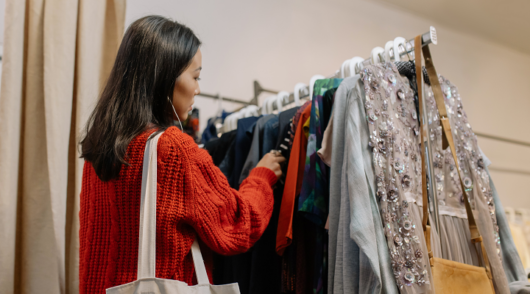Sydney International Airport Airport retail appears to have it all. Long passenger dwell times, high foot traffic, an abundance of cashed up jetsetters (thanks to new airline partnerships), and extended trading hours, operating 365 days a year. But, believe it or not, despite its perks, airport operators are battling the same challenges faced by traditional bricks and mortar retailers. “There’s more similarities
than differences,” says Andrew Gardiner, GM of retail at Sydney Airport, on the two categories.
“We can’t just take for granted that we have passengers coming through, we have to have lots happening,” he said.
In 2010, Sydney Airport underwent a major overhaul. The country’s largest airport became home to Australia’s first Victoria’s Secret, the world’s first Lonely Planet’s concept store, and fast food giant, McDonald’s, opened its largest airport outlet in the world.
Three years on and Sydney Airport is entering another growth phase.
With more than 60 million passengers passing through its T2 Terminal each year, the airport has lined up a number of yet to be named domestic and international retailers, expected to set up shop within the next six months.
The move is a clear sign of the times – competition remains rife, and retailers, wherever they may be, cannot afford to become complacent with their offering.
“We have to make sure we are always innovative and fresh,” Gardiner told Inside Retail Magazine.
Valiram Group, also known as Luxtralia, declined to participate in this feature, but operates the Australian arm of the Victoria’s Secret brand.
The US-based lingerie label has continued to flourish in Australia, opening its seventh local airport store in Perth earlier this year.
“We look for freshness and for newness. Not that long ago Sydney Airport had the first Victoria’s Secret store in Australia,” comments Gardiner.
“It’s been tremendously successful for the Victoria’s Secret brand. Productivity levels are very high and they’re really happy, but we have to continually scan to look for what’s new, what’s fresh, and ask, ‘what retailers do customers want to shop at in Sydney airport’?”
In February, Brisbane Airport Corporation (BAC) called for expressions of interest for a new seven year duty free contract at the soon to be revamped Brisbane International Terminal.
The duty free arrangements are part of a major redevelopment of the International Terminal planned for the coming years, and aims to capitalise on the traveller mindset.
“You’re actually in a different mindset when you’re travelling internationally, explains Andrew Brodie, GM of retail and commercial, BAC.
“Once you get through customs, you’re relaxed, you’re ready to spend some money, you’re about to go on this fantastic holiday, so your emotions are very different from high street type shopping,” Brodie says.
In the traditional sense of retail, international brands are opening sites quicker than you can say fast fashion, but in the airport space, growth for now, seems to have slowed.
“I wouldn’t say that we’re seeing more or less [retailers], I would say that passengers are expecting more choice with the product range that they’re offered,” says Brodie.
LS Travel Retail Asia Pacific, formerly known as Lagardere Services Asia Pacific, is one of the biggest airport retail operators in the country.
Brands in LS Travel Retail’s portfolio include Billabong, Fashion Emporium, News Link, Kaboom, Relay, and Virgin Entertainment.
Lonely Planet, also under LS Travel Retail’s banner, told Inside Retail Magazine it “just makes sense” to have an airport presence.
“We’re not really interested in high street retail because our brand is all about travel,” says Chris Zeihner, sales and marketing director of Lonely Planet Asia Pacific.
The store in Sydney has been trading for just under three years, with customer dwell times averaging 10 minutes per person in store.
In August, the brand will introduce travel accessories to its offering, which will include eye masks and drink bottles.
“Our preference is to be at an international airside because you’re capturing a target market for all those dwell times,” Zeihner says.
Since opening in Sydney, Lonely Planet has opened a store at Manchester Airport in the UK, and at Kuala Lumpur’s International Airport in Malaysia.
“We definitely want to see more Lonely Planet airport stores across the world. That’s a part of our long term retail strategy.”
LS Travel Retail is making a concerted push into the airside accessories sector.
“We’re seeing significant growth in technology accessories,” says Matthieu Mercier, CEO of LS Travel Retail Asia Pacific.
“We’ve actually created a brand in that segment called Tech2Go and it has been very successful,” Mercier said.
“It’s something we believe will stay for a long time. The iPad, iPod, and the iPhone have created a huge market for accessories, and [technology accessories] are across all segments.
“You can buy your headphones in a bookstore, but you can also buy them in a duty free store, or luxury store.”
Australian and New Zealand passengers make up the bulk of foot traffic at most major airports.
Brisbane International derives around 60 per cent foot traffic of its from Australian and New Zealand shoppers, with Aussies making up the majority at 40 per cent.
The airport has seen a spike of 19 per cent in the number of Chinese passengers over the past 12 months.
“Chinese are our fourth largest passenger nationality but our highest growth nationality over the last 12 months,” Brodie says, with Chinese customers spending between two to three times more than Australian or NZ passengers.
Other strong markets include Korea (10 per cent) and India (10 per cent), followed by the US (eight per cent).
Sydney Airport is seeing similar growth rates from Asian travellers, reporting 9.4 per cent growth in Chinese passengers in the last year, and 5.3 per cent growth in international passengers overall.
Says Gardiner: “We’re finding a lot more Australians are travelling and a lot more Chinese are coming to the country, and with that we’re seeing the luxury goods doing really well.”
High end brands such as Burberry and Mont Blanc are continuing to churn out strong results at Sydney, as well as duty free – the largest duty free store in the southern hemisphere at 3000sqm.
“It’s only an eight hour flight up to Hong Kong so it’s very easy to bring Chinese people to Australia.”
New alliances between local airlines, Virgin and Qantas, with international carriers, (including Qantas’ most recent deal with Middle Eastern airline, Emirates), is also beginning to change the face of the country’s target demographics.
“Middle Eastern is a big growth market for us, and India – those are the markets that we are really targeting for growth now,” says Gardiner.
Sydney Airport plans to extend its menu offerings to cater for Middle Eastern flyers, as well as reviewing its duty free product mix.
“We’re looking at our value really closely and from a duty free perspective to make sure that it’s relative and providing choice for our customers – that’s really important.”
Sydney is also putting a bigger focus on its ‘grab and go’ convenience offering, as more customers jump on board with low cost airlines such as Jetstar and Tiger.
In Brisbane, skincare, healthcare, and food and beverage, are key areas marked for growth.
Not so rosy
There is one sector that has taken a hit following new government legislation: tobacco.
In September 2012, the Federal Government slashed the duty free allowance of cigarettes for in-bound passengers from 250 to 50, with any excess having to be declared for payment.
“Because of the recent tobacco legislation, sales of tobacco have fallen off quite considerably,” says Gardiner. “All the other sectors are growing though.”
But staying afloat in the industry is tough work and John Chapman, CEO of Airport Retail Enterprises (ARE), believes the retail model in airports is “a lot more complicated”.
The privately owned Brisbane-based company operates some of Australia’s leading food and beverage outlets such as Bar Roma, Quikshots, Go! Convenience, and Brasserie Bread.
“There are typically higher charges from a rental perspective, and it’s more complicated on the basis that in some instances, not all, your trading day can stretch as far as 22 hours,” Chapman told Inside Retail Magazine.
“Staff management and control, security procedures, and things like that have to stretch and cover those periods. Even if you’re an owner/operator it’s not an easy task to be there for that amount of time.”
Fitout trends
According to Mercier, store designs are being influenced by an airport’s location.
“The idea that the airport should reflect the region that it’s based in is growing stronger and stronger,” Mercier explains.
“To some extent, we try to take this into account when planning a store. There are some brands that we work with who are high street brands and it’s not always possible to adapt the concept, but wherever we can, we try to include it.
“To me, laying out the terminals is like laying a department store, looking at all the different merchandise classifications that we have, and saying, ‘how do we fit them and how do we make our customer get what they want’?” says Gardiner.
In the duty free arena, merchants are continuing to use walk-through models.
Features of Brisbane’s new international retail environment will include larger walk through duty free tenancies for arrivals (800sqm) and departures (1600sqm).
“The obvious benefits of this are that you have 100 per cent penetration – every departing or arriving passenger walks through your store,” says Mercier.
“It also changes the way you have to address the customer. They don’t make the conscious choice of entering your store. They’re in there without knowing it, so you have to capture their attention in a different way.”
Products like iPads and computers are causing some passengers to “escape” rather than shop, while waiting for a flight.
“They’re physically here but they’re not in the mood to shop because they are captured by something else. Retailers have to attract their attention so that they will actually enter the store.”
Digital interaction such as LED screens and digital POS displays are effective ways for airport retailers to capture data.
Brisbane’s International Airport will have a greater digital and interactive focus.
“Everyone has smartphone so this is really at the forefront,” says Brodie, on the airport’s future store design.
“[Technology] is changing and it can be now updated remotely. What we’re seeing is, because we have different nationality profiles coming through our terminal, we can quickly change content from English to Mandarin to Korean.
“Our duty free retailers use that technology, and we have a number of specialty retailers who are exploring that space.
“We are in the process of going through a planning stage for a major redevelopment of our terminal and as part of that process, retailers who will be joining us post development, technology which play an integral part of that.”
This story originally appeared in Inside Retail Magazine. The August/September issue, featuring exclusive coverage of the 2013 Westfield World Retail Study Tour is available now. For more information, click here.







